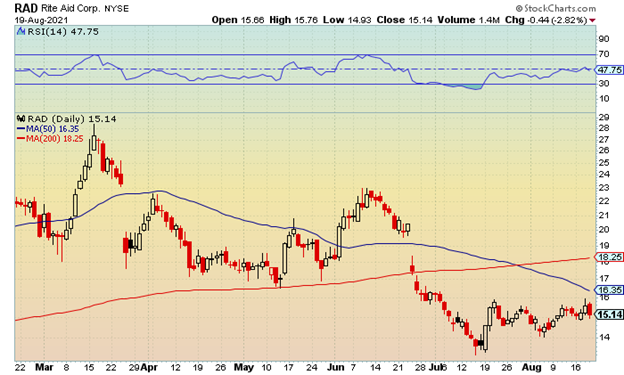Shares of Rite Aid (RAD) came into 2021 on a roll after rising from a 52-week low of $8.86 to hit a 52-week peak of $32.48 in late January. Some of the bullishness here was the result of Rite Aid being a so-called “meme stock” that Reddit traders had on their radar.
Other meme stocks that have been targets of short sellers, but RAD has been a short candidate for years by traders who believe the company would, or will, go bankrupt. Although RAD’s fundamentals have improved over the years, the company remains a risky investment based on its choppy earnings results.
In June, RAD reported first-quarter earnings of $0.38 per share on revenue of $6.16 billion. (Analysts were expecting a profit of $0.22 and $6.21 billion, respectively.) Same-store sales from continuing operations increased just 1.4% over the prior year period, with an 8.2% increase in pharmacy sales and a 12% decrease in front-end sales.
To the company’s credit, Rite Aid has said it’s provided more than six million COVID-19 vaccines since beginning to administer shots late last fiscal year. However, the inability to do follow-through sales at the front end of the store is a key concern going forward.
In April, RAD reported a fourth-quarter loss of $0.78 per share versus forecasts for a loss of $0.76. Although the company topped revenue with $5.82 billion in sales versus estimates of $5.8 billion, the company is expected to post a loss of $0.42 for the current quarter, with results due out in late September.
For fiscal year 2022, RAD is expected to post a loss of $0.79 per share, and for 2023, a loss of $0.15 per share. For a company that will likely post revenue north of $25 billion in both years, this is a big disappointment. It’s also why earnings will likely remain choppy into the foreseeable future.
As far as the technical setup, a death-cross formed in late July with the 50-day moving average falling below the 200-day moving average. This is typically a bearish signal for lower lows. Shares recently traded near $16 and key resistance from late July with this level holding. The prior rebound in mid-July towards $16 came off a low of $13.36.

The July 15 low reached $13.22, and shares could do a retest towards $13.25 over the near-term on renewed weakness. There is a good chance a further fade towards $12 comes into play and levels from last December if shares fall to hold $13.25–$13.
Aggressive traders can target the regular RAD September $15 puts that recently traded near the $1 level and expire on September 17. These put options would be at least $2 in the money for a quick 30-day or less double-up if shares fall below $13 by mid-September.
If there is a further fade towards $12, which is to say if shares fail to hold $13, the aforementioned put options would be $3 in the money for a gain of 200% if reached by September 17.
If shares rebound from here and recover $16–$16.25 and the 50-day moving average over the next few weeks, traders can exit the position to save the remaining premium.
— Rick Rouse
Your 12 income checks supercharged with 21% yields [sponsor]Imagine having 12 new monthly income checks, carrying the potential of up to 21% yields.This is possible because of a tested strategy to get paid out regularly, like a paycheck. For over a decade, I have helped more than 26,000 investors secure 12 new monthly payouts. Meaning, you know exactly how much you'll make every month... Because of some stocks that pay us 8%,13.4%, and even 21.6% yields. See it for yourself here.
Source: Investors Alley
